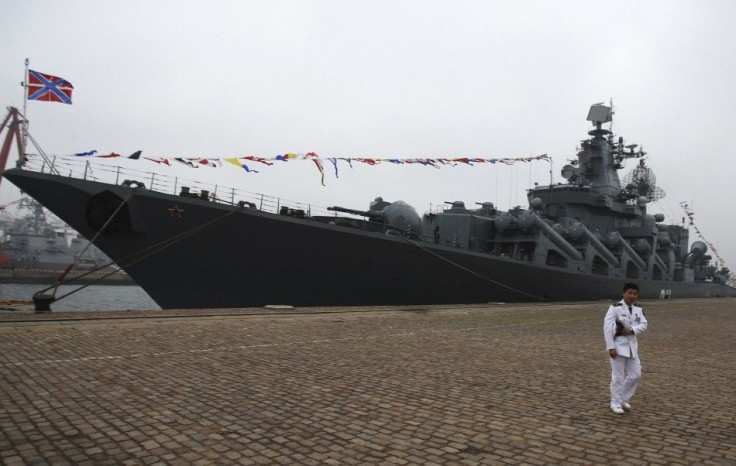US Worried As China And Russia Prepare To Hold Historic Joint Naval Exercises

China and Russia are making military history this weekend with the first bilateral naval exercises the two governments have ever conducted together.
China is sending a group of 16 ships, including destroyers, frigates, and a hospital ship. Russia is sending 4 ships, including the cruiser Varyag and three air defense destroyers now moving south from Vladivostok to join the Chinese after navigating through the Sea of Japan.
Another Varyag, though, might steal the spotlight from the assembled fleet. It is the Chinese aircraft carrier of the same name, the first carrier in the People's Liberation Army Navy. Even though China has not said whether it will be participating in the joint exercises, it might.
The state-owned China News Service reported Friday that carrier trials may take place April 20-29 -- an interesting overlap with the China-Russia joint exercises April 22-27.
In fact, the carrier doesn't even have an official name yet. Military analysts just refer to it as the Chinese Varyag, as it has been called since China bought the ex-Soviet hulk from Ukraine and towed it to its port of Dalian, under the official explanation that it was going to be turned into a floating casino.
Last August, after almost 10 years of fanfare in China and a decade of anxious observation by the U.S. and Japan, the Chinese government finally conceded that the newly painted, newly renovated warship that sat in Dalian harbor would indeed become China's ticket into the very small club of nations that have aircraft carriers.
China's aircraft carrier remains largely unmanned, and no planes have ever lifted off from or landed onto its flight deck, but observers are wondering whether that will happen during the coming sea trials. That would raise China's capabilities for sea warfare to a new level.
As for the Russian Navy's Varyag, it was built during the Cold War to target major U.S. assets in the Pacific, and it would have used its fast supersonic missiles to sink large American ships in case of a breakout of hostilities during that period.
Including a ship purpose-built to hunt U.S. carriers may lead some to think the Sino-Russian exercises are really directed at America -- and its closest ally in the region, Japan.
Yet China, even with Russian support, isn't close to matching American naval power. It now has more than 500 combat ships of all types in its navy, but many are old, small, and incapable of operating far from shore. The U.S. has more than 280, a smaller number, but ship-for-ship much more capable. And in terms of gross tonnage, the U.S. navy outweighs the next 12 fleets in the world combined.
Even so, the U.S. and Japan are deeply worried.
Over the past decade, the People's Liberation Army Navy has demonstrated that it can build large, technically complex ships, armed with advanced sensors and powerful weapons.
The U.S. Navy is particularly concerned about the combination of quiet submarines, potent anti-ship ballistic and cruise missiles, anti-satellite weapons, and modern airpower that China can now deploy against its forces in the Western Pacific. The Pentagon has noted in the past that if hostilities emerged between the two countries, China could leverage these asymmetric capabilities to deny the U.S. access to maritime zones in the East China Sea and South China Sea.
Meanwhile, the Chinese navy is also demonstrating that it can construct larger ships, train for more complicated missions (including humanitarian assistance), and operate farther away from home shores than ever before. China's recent deployment in an anti-piracy mission in the Gulf of Aden includes the largest warship the country has ever constructed, a 20,000-ton amphibious-warfare ship. Last year, when China evacuated 30,000 of its citizens from Libya, it sent destroyers into the Mediterranean Sea to escort them.
As for the exercises beginning Sunday, China said they will deepen the strategic and cooperative relationship [with Russia]. The aim of the exercises is to improve abilities to respond together to new challenges and new threats, and protect the Asia-Pacific region and world peace and stability. The official statement names no countries, but there is little ambiguity as to which one China means in the reference to new challenges and new threats.
The U.S. Defense Department has crafted a new doctrine for its forces, the Air-Sea Battle Concept, to better deploy technologically advanced naval and air forces in a comprehensive way against a well-prepared, well-defended, industrialized state opponent.
The doctrine marks a major strategic redirection away from fighting small, stateless armed groups, which was the predominant concern of the Pentagon during the past decade -- and that is a fact not lost on the Chinese.
A Chinese defense-ministry representative, Col. Geng Yansheng, called the Air-Sea Battle Concept a manifestation of Cold War mentality. And Rear Adm. Yang Yi (ret.) called it a means to undermine peace, stability, and prosperity in the Asia-Pacific region. To understanding people, it is clearly targeted at China's military modernization, said the former Chinese naval officer.
© Copyright IBTimes 2024. All rights reserved.





















